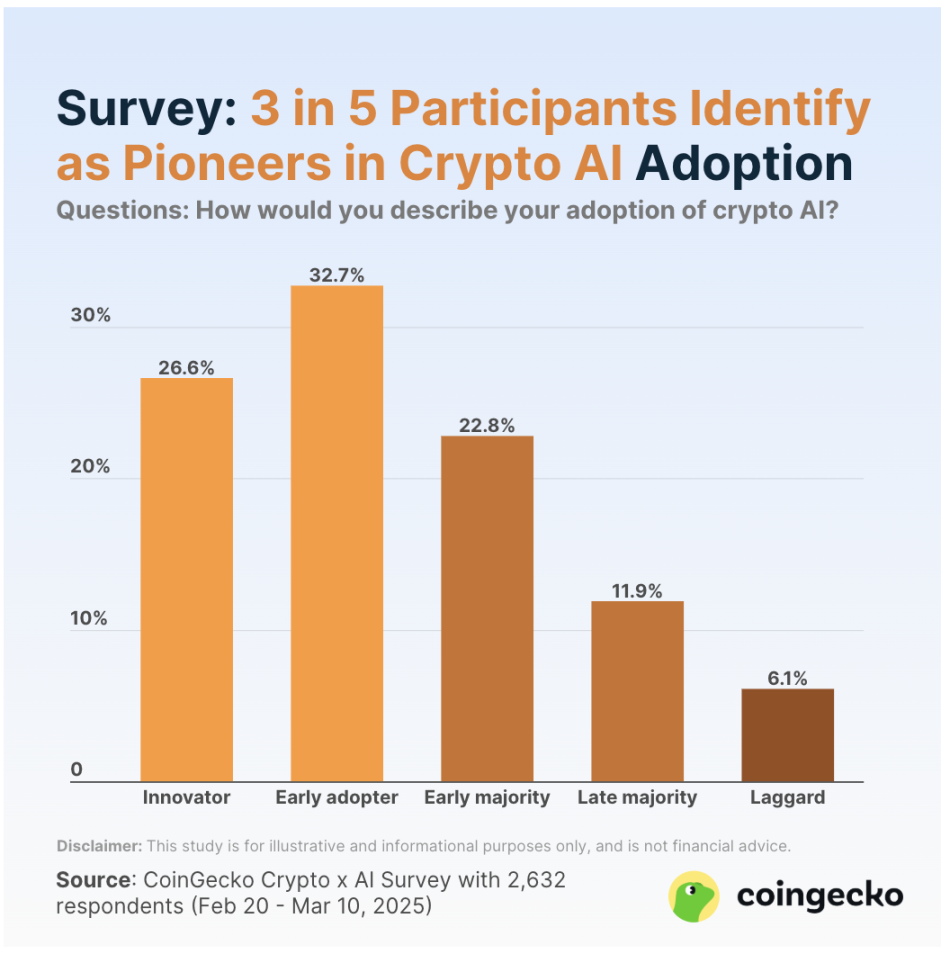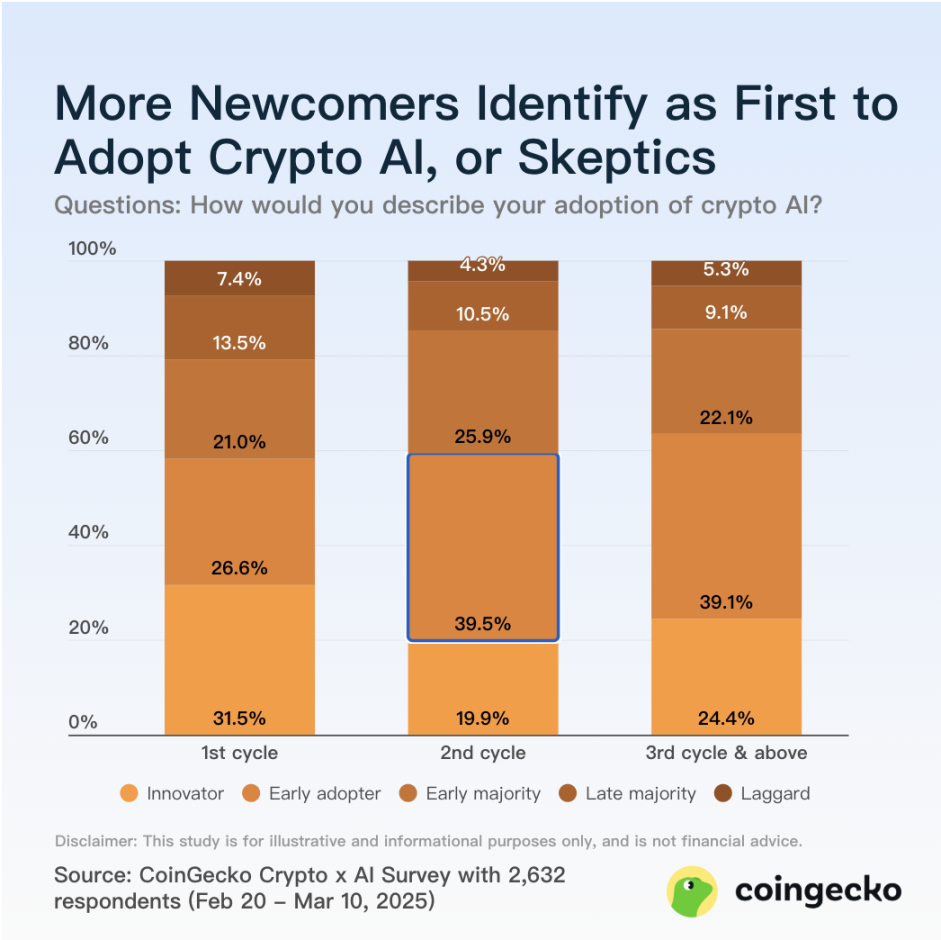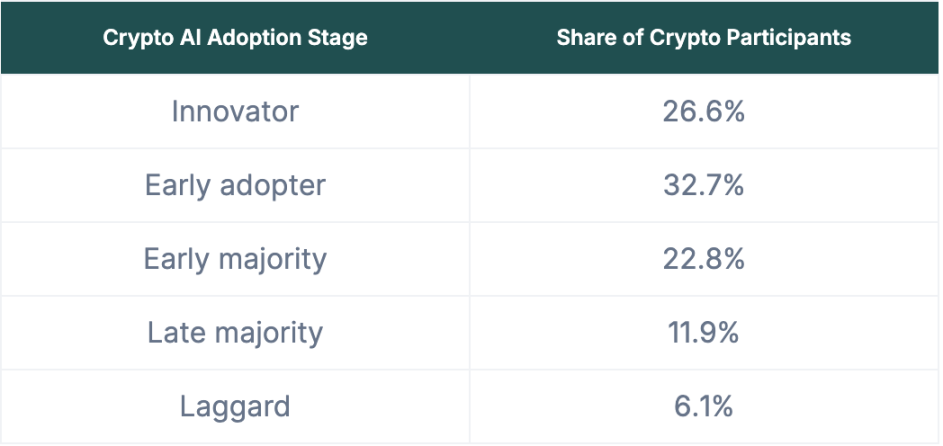Coingecko survey: Who is buying AI tokens?

Reprinted from panewslab
04/11/2025·19DAuthor: Yuqian Lim
Compiled by: TechFlow
How popular will the application of encryption AI be in 2025?
In a survey conducted this year, 59.3% of crypto industry participants (nearly three-fifths) considered themselves the “first adopters” of crypto AI. Another 34.7% of participants classified themselves as "mainstream users" of encrypted AI applications, while the remaining 6.1% were "skeptics" with the lowest willingness to adopt encrypted AI.
Compared with the bell-shaped curve distribution that technology applications usually follow, the proportion of "pioneer adopters" in encrypted AI is an extremely high. This phenomenon may be related to the self-selecting bias of participants' own interest in encrypted AI, but it also reflects that the application of encrypted AI is still dominated by technology enthusiasts and has not yet truly achieved mainstreaming in the encryption industry.

Among these "pioneer adopters", 26.6% of participants defined themselves as "innovators" (i.e., tech enthusiasts who are keen on chasing new technology narratives), while 32.7% agreed that they were "early adopters" who were sensitive to trends. The larger proportion of "early adopters" may reflect the latest change in industry perception that the crypto industry is gradually seeing crypto AI as a key area with potential, not just a hot topic of hype.
Meanwhile, 22.8% of crypto industry participants classed themselves as the “early majority” of crypto AI applications, almost twice the 11.9% who define themselves as the “latest majority”.
This shows that the main challenge of encrypted AI is to promote applications of those pragmatic and more risk-averse mainstream populations. To attract an "early majority" user base, crypto AI projects may need to clearly demonstrate their ability to solve practical problems or create value for users.
Ultimately, only 6.1% of participants classified themselves as skeptical and resistant to change-resistant “Laggards”, a proportion that matches the tail end of a typical bell-shaped curve distribution. These "laggards" may include realists who are only interested in monetizing AI, AI critics, and cautious users who are waiting for more mature technology.
More crypto novices are polarizing their attitudes toward encrypted AI
applications
It is worth noting that among the participants who have experienced the market cycle for the first time, 31.5% define themselves as “innovators” in crypto AI applications, while 7.4% consider themselves “laggards.”
Both of these proportions are higher than those who experienced the second market cycle (19.9% are “innovators”, 4.3% are “lagging”) and veteran users (24.4% are “innovators” and 5.3% are “lagging”).
This suggests that crypto novices may have a stronger and more diverse view on the narrative of encrypted AI, especially since some new users may have entered the crypto space by being attracted by the recent crypto AI boom.

On the other hand, participants who have experienced the second market cycle have similar distributions in terms of attitudes toward encrypted AI applications. The only difference is that participants in the second market cycle account for a slightly higher proportion of the “early majority” group, while senior users account for a higher proportion of the “innovator” group.
Encryption AI Application Curve in 2025
The crypto market's interest or application attitudes towards crypto AI are as follows:

Methodology
This study is based on an anonymous CoinGecko Encryption x AI survey, which was conducted from February 20 to March 10, 2025, and a total of 2,632 participants in the crypto industry were collected. The survey results are for reference only.
Among respondents, 51% defined themselves as crypto investors who mainly hold long-term assets, 26% were traders who mainly hold short-term assets, 10% were developers who work in construction, and 13% were onlookers. In terms of participants’ qualifications in the crypto field, 53% were newcomers who experienced the market cycle for the first time (0 to 3 years), 34% were users who experienced the market cycle for the second time (4 to 7 years), and the rest were senior users with 8 years or more experience. From a geographical perspective, 93% of respondents came from Europe, Asia, North America and Africa, while the rest were located in Oceania or South America respectively.
This study is for illustration and reference only and does not constitute any financial advice. When investing in any crypto or financial assets, be sure to research and act with caution.
If we cite insights from this study, we hope you can provide links to this article by CoinGecko, which will help us continue to provide you with valuable data-driven content.



 chaincatcher
chaincatcher